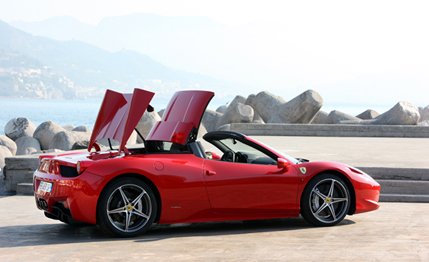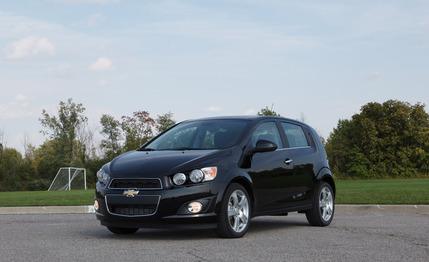 Short Take Road Test
Short Take Road Test

While we’re of the strong belief that you can’t dig half a hole, we do know with absolute certainty that it takes only time to dig one heck of a deep one. Give a car company, oh, four decades, and you might be surprised just how deep that hole can get. Witness the veritable parade of losers that is Chevrolet’s historical lineup of small cars: Vega, Chevette, Sprint, Aveo—and let’s not forget the Geo/Chevrolet Metro. (To be fair, tiny cars from GM’s domestic competition have rarely been much better.)
One could have imagined Chevy fitting its new Sonic with a winch and a hard-core four-wheel-drive system with locking differentials and a low-range transfer case: How better to extricate itself from the Abyss of Those That Came Before? Instead, Chevy simply focused on making its small car a good car. The result is an unprecedented success.
Small and Stiff
Even from a purely aesthetic standpoint, the Sonic is a home run. With dinky wheels, drab sheetmetal, and a protuberant proboscis, the Aveo was a gas-fired dork. The Sonic looks more bully, with sharp creases, an angry slant to the headlights, an aggressive rearward cinch of the beltline, and beefy fender flares. In its final years, the Aveo looked sort of decent inside, but the Sonic’s thoroughly considered interior design and upscale detailing make even the best Aveo look old. Front and center sits an analog tach—needle hanging straight down at rest—flanked by a digital cluster that reports the rest of the info you need to know.
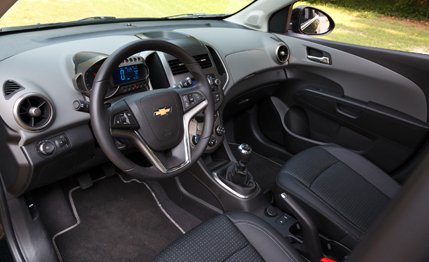
Grab the steering wheel and you’ll notice nice, chunky ears at 10 and 2. The rest of the rim is a bit thin, but those flanges are perfectly shaped, with a natural contour and a comfortable plane to rest the pad of your hand. Fire up the Sonic and saw at that wheel, and you immediately realize how quick the steering is. This is among the most satisfying drivers in the segment. The steering is sports-car quick—almost too tight for relaxed cruising, with even the slightest inputs prompting directional changes.
The Sonic rides on an all-new platform that is 77 percent stiffer than the Aveo’s. It has an extra 1.8 inches of wheelbase, expanded tracks front and rear, and is several inches longer in both hatchback and sedan body styles. For its part, the stiffer body structure transmits barely a shudder over the roughest roads, and the suspension minimizes body roll without battering occupants. The sense of solidity comes at a cost, though: The Sonic is much heavier than most cars in its class. At 2808 pounds, it carries 500 or so more than the average Mazda 2. When you’re talking about cars that weigh under 3000 pounds, that can be a disastrous difference. Fortunately, it hides its weight well, with an agile and responsive feel, and posts a best-in-class 0.81-g skidpad performance despite an addiction to understeer at the ragged edge.
High Praise for High Tech

We were likewise surprised by the 138-hp, 1.4-liter turbo four. It’s a gem, much easier to appreciate here than in the heavier Cruze. There is very little lag, power delivery is smooth, and it never groans in complaint like so many other econocar engines. (A naturally aspirated 1.8-liter four is the Sonic’s base engine.) The Sonic’s 1.4 runs out of breath way before redline, though; the fuel cutoff is at 6500 rpm, but shift by 6000 if you want to keep things moving. We saw 60 mph in 8.2 seconds on our best acceleration run, and we snuffed the quarter-mile in 16.5 at 85 mph. A small engine and an upright body are not a good combo for high-speed runs; the Sonic needs 24.7 seconds to hit 100—although that’s almost as good as it gets in this class.
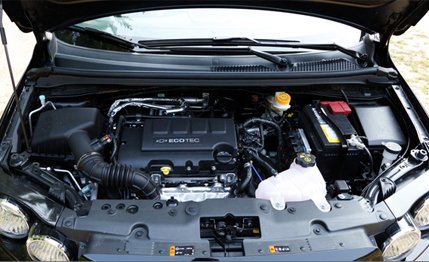
In a move that we’ll assume is blatant pandering, Chevy offers the turbocharged 1.4 only with a six-speed manual. The shifter has a precise bite, although the throws are a bit long. The clutch is pretty bad, with almost no feel; it’s good that take-up is so slow, as it covers a lot of the clumsiness that results from the radio silence between disc and pedal. There are a lot of bad clutches at the low end of the market, and this is far from the worst, but it is just as far from rewarding. When you decide to turn your Sonic into a fire-breathing track beast, this is one of the first pieces you should upgrade. (A five-speed DIY’er is standard with the naturally aspirated 1.8-liter. It also can be had with a six-speed automatic, a gearbox which is likely to be offered with the turbo sometime in the near future.)
The six-speed’s tall gearing couples with a tall final-drive ratio to keep engine rpm remarkably low at highway speeds: At 70 mph, the 1.4 is barely turning 2100 revs. While you’ll need at least a two-gear drop to find any power, that gearing helps the Sonic achieve 40 mpg highway in the EPA’s testing. We saw 31 overall.
Lots of Space in a Little Footprint
Thanks to its hatchback body, the Sonic has decent space all around. The front seats are comfortable and supportive, and there’s a fair amount of room in the back seat. At 41 cubic feet, the rear accommodations are among the roomiest in the segment, and the hatch boasts a slim 0.3 inch more rear headroom than the sedan. It’s not all sunshine, though: While the 19 cubes of storage lag behind the class leaders only a bit, the opening to access that space is narrow, hemmed in on both sides by the Sonic’s mongoloid rear-light fixtures. And folding the rear seats doesn’t net nearly the volume it does in, say, a Honda Fit. The Sonic’s 31 cubes are a woefully uncompetitive 54 percent of the class-leading Honda’s 57-cubic-foot figure.
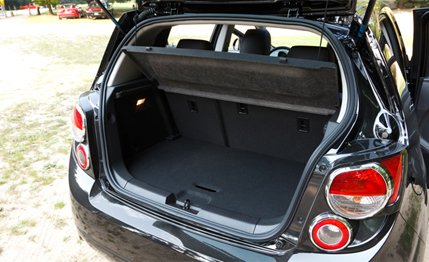
But the Sonic once again finds itself at the desirable end of the spectrum with its standard and available equipment. Even a $15,395 base Sonic LS five-door, which comes with a poverty-class AM/FM radio and just four speakers—but an auxiliary input—is fitted with 10 airbags: driver and passenger front, side, and knee; full-length side curtains; and side bags for rear passengers. A tilting and telescoping steering column, power locks, and automatic headlights also are standard on all cars. The midlevel LT trim, at $16,495, upgrades the stereo with two more speakers, satellite radio, and a CD player, plus adds heated power mirrors, power windows, chrome exterior trim, and nicer seat cloth. More important, it opens up the option of the 1.4-liter turbo, which costs just $700. Do it. (If $700 breaks the bank at this price point, then you’re shopping above your head; get a used car instead.)
At $17,995, an LTZ model like the one tested here adds Bluetooth connectivity, fog lights, more chrome trim, a USB input, faux-leather seats (heated up front), plus a leather-wrapped steering wheel with audio and phone controls. Cruise control, part of a $375 package on LT cars and unavailable on the LS trims, is standard on LTZs. Add $700 for the 1.4 and another $850 for a sunroof, and our Sonic stickered at a rather lofty $19,545. Without the big hole in the roof, it’d be $18,695.
The Sonic’s $15,395 base price is a little high for this class, but only barely. Yes, the backmarker Nissan Versa starts at $11,750, but it is terrible and therefore doesn’t count; the $15,165 Mazda 2 is the only desirable competitor to undercut the Sonic. The $15,945 Honda Fit and $16,295 Ford Fiesta hatch are there, too, but require you to open your wallet a little wider. All three, of course, climb the price ladder when you start checking options; in that light, the $17,195 buy-in for a nicely equipped turbo Sonic seems fair.
Chevy’s newest small car has clambered not only out of the pit dug by its predecessors, but right up toward the top of the small-car heap—especially with the turbo.
